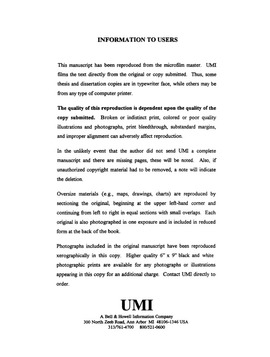| dc.contributor.advisor | Frech, Roger, | en_US |
| dc.contributor.advisor | Dryhurst, Glen, | en_US |
| dc.contributor.author | Cole, Renee Susan. | en_US |
| dc.date.accessioned | 2013-08-16T12:30:04Z | |
| dc.date.available | 2013-08-16T12:30:04Z | |
| dc.date.issued | 1998 | en_US |
| dc.identifier.uri | https://hdl.handle.net/11244/5653 | |
| dc.description.abstract | This work illustrates the necessity of using a variety of techniques when characterizing these systems, which undergo complex structural changes that cannot be completely characterized using a single technique. The XRD results indicate a complete transition from $\alpha$- to $\gamma$-Na$\sb3$PO$\sb4$ with no intermediate structures present. The DSC thermograms show the presence of a perturbed $\alpha$- or $\gamma$-phase, but generally agree with the phases identified by the XRD patterns. Vibrational spectroscopy provides a richer description of the local structural changes occurring. | en_US |
| dc.description.abstract | Na$\sb3$PO$\sb4$ has two solid phases: the tetragonal $\alpha$ phase, stable to 320$\sp\circ$C, and the cubic $\gamma$ phase, stable from 320$\sp\circ$C to the melt at 1500$\sp\circ$C. Initially, a factor group analysis of the expected modes and their symmetry-based assignments was performed for these two phases. A temperature-dependent Raman study was then performed for the pure compound. The bands change from sharp multiplets to broad bands with increasing temperature. The broad bands and collapsed band structure seen in $\gamma$-Na$\sb3$PO$\sb4$ are indicative of the high disorder present. | en_US |
| dc.description.abstract | The stabilization of polymorphic compounds has been of interest for some time. Previous studies have shown it is possible to stabilize the high-temperature, fast-ion-conducting phase of sodium phosphate (Na$\sb3$PO$\sb4$), but these systems have not been thoroughly characterized. Therefore, a systematic study was conducted of pure Na$\sb3$PO$\sb4$ and solid solutions of Na$\sb3$PO$\sb4$ doped with Mg$\sb3$(PO$\sb4)\sb2$, Zn$\sb3$(PO$\sb4)\sb2$, Na$\sb2$SO$\sb4$ and ZnSO$\sb4.$ The techniques used in this study were Raman and infrared spectroscopies, differential scanning calorimetry, and powder x-ray diffraction. | en_US |
| dc.description.abstract | $\gamma$-Na$\sb3$PO$\sb4$ is stabilized in all four dopant systems. The percentage of dopant necessary for complete stabilization is different for anion, cation, and combined dopants. The two cation dopant systems, Na$\sb3$PO$\sb4$/Mg$\sb3$(PO$\sb4)\sb2$ and Na$\sb3$PO$\sb4$/Zn$\sb3$(PO$\sb4)\sb2$, exhibit similar behavior although the Raman spectra indicate that Zn$\sp{2+}$ has a stronger interaction than Mg$\sp{2+}$ with the PO$\sbsp{4}{3-}$ ion. The Raman spectra in the Na$\sb3$PO$\sb4$/ZnSO$\sb4$ system exhibit characteristic bands seen in both the Zn$\sb3$(PO$\sb4)\sb2$- and Na$\sb2$SO$\sb4$-doped systems. A remarkable characteristic of $\gamma$-Na$\sb3$PO$\sb4$ is the amount of aliovalent substitution that can be accommodated in the lattice before phase separation or compound formation occurs: 11% Mg$\sb3$(PO$\sb4)\sb2$ or Zn$\sb3$(PO$\sb4)\sb2$, more than 30% ZnSO$\sb4$, and over 60% Na$\sb2$SO$\sb4.$ | en_US |
| dc.format.extent | xviii, 161 leaves : | en_US |
| dc.subject | Engineering, Materials Science. | en_US |
| dc.subject | Chemistry, Inorganic. | en_US |
| dc.subject | Chemistry, Analytical. | en_US |
| dc.subject | Sodium phosphates. | en_US |
| dc.subject | Solid state chemistry. | en_US |
| dc.subject | Chemistry, Physical. | en_US |
| dc.title | Characterization of pure and phase-stabilized sodium phosphate. | en_US |
| dc.type | Thesis | en_US |
| dc.thesis.degree | Ph.D. | en_US |
| dc.thesis.degreeDiscipline | Department of Chemistry and Biochemistry | en_US |
| dc.note | Source: Dissertation Abstracts International, Volume: 59-07, Section: B, page: 3457. | en_US |
| dc.note | Advisers: Roger Frech; Glen Dryhurst. | en_US |
| ou.identifier | (UMI)AAI9839787 | en_US |
| ou.group | College of Arts and Sciences::Department of Chemistry and Biochemistry | |
